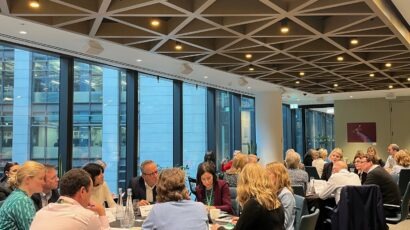
Same industry, different models: Burberry & Baukjen on meeting climate ambitions
No journey to net zero is straightforward. It can be difficult for board members to know what actions to take and to find examples and inspiration from other companies tackling the same issues. Julie Brown, Chief Operating and Financial Officer, Burberry, and Geoff van Sonsbeeck, Co-Founder and CEO, House of Baukjen, joined us to share invaluable insights from their experiences and reinforce the importance of collaboration and purpose when moving climate ambition to action.
Same industry, different models
Burberry is a global, long-established business adapting its existing business model, and Baukjen is a London-based BCorp, founded in 2003 and designed around sustainability. These different sized businesses have a common climate ambition and have both been recognised for their progress so far.
Established over 160 years ago, Burberry is a brand with sustainability woven into its heritage as its founder was driven by nature and the outdoors. The business has been reinforcing the company’s sustainability agenda and in June 2021 it pledged to be climate positive by 2040. This will involve significant emissions reductions across the supply chain, reducing Scope 3 emissions by 46%. Since 2016 Burberry has already cut emissions by 92% and this year will be carbon neutral within its own operations. It was one of the first companies to set a 1.5C SBTi target, and also has a biodiversity strategy. It was named Climate Leader in ICAEW’s Finance for the Future Awards 2021.
You often hear that encouraging sustainability leads to business growth, but actually it leads to a business. If we don’t get this right, we won’t have a business.
Julie Brown, Chief Operating and Financial Officer, Burberry
Moving to a circular model
By contrast, Baukjen is a much younger business, and even though it was established with sustainability at its core, it has still had to develop its business model to include circularity. Since 2019 it has been a zero waste and plastic company and won a 2021 UN Global Climate Action Award in the Climate Neutral Now category for reducing its footprint through redesigning its business model.
This has included looking at the whole supply chain and garment journeys, down to the raw material. Baukjen has also been exploring how to communicate this to customers and give full visibility of the garment, its origins and journey. The business has also been looking for inefficiencies in the supply chain to identify opportunities to become more profitable and balance other expenses brought about by change, but also to move itself and its suppliers out of wastefulness.
Being a smaller business means we’ve had the luxury to rethink about how we can move into a more circular model, but it does also take courage.
Geoff van Sonsbeeck, Co-Founder and CEO, House of Baukjen.
Both businesses are making progress towards their climate ambitions but there is still much more to be done. They are starting from different positions, and yet they face similar challenges that resonate with all businesses, wider than the retail sector.
Engaging the supply chain
From a board perspective, how can you ensure the operations team is doing the right thing when it comes to Scope 3 emissions and the supply chain?
Scope 1 covers direct emissions from sources owned or controlled by the company
Scope 2 covers emissions from the generation of electricity purchased by the company.
Scope 3 refers to all other indirect emissions within a company’s value chain and often contains a large proportion of emissions that need to be addressed.
Julie explained that 95% of Burberry’s emissions come from the wider supply chain. With large and complex businesses, you can make strong progress on your own operations, but to address all emission scopes that progress needs to extend across all major suppliers.
How can boards start to tackle their Scope 3 emissions?
- Asking for traceability of materials to be ensured by looking at major suppliers, understanding their values and net zero plans.
- Collaborating with competitors to provide the impetus for shared major suppliers to improve their own operations and emissions.
- Calling for a clear reporting framework or set of standards appropriate across the industry.
- For smaller businesses and smaller suppliers in particular, how can you motivate them to potentially do something a bit unconventional? Industries and sectors are changing, how can you excite and inspire your supply chain to stay at the front of that with you?
These are all valuable points that were discussed during the conversation.
Should we lead or should we follow?
Another theme raised was consumer demand and what approach to take. Especially relevant to the retail sector is the question ‘do we lead or do we follow’? Do we ‘teach’ the customer, or wait until the demand comes? Will that achieve the change we need?
Certainly this can be a question for many businesses, especially when thinking about how far and fast to change and set ambitions. The fashion industry is a big scaler and shaper of consumer demand and that was a point of discussion.
Similarly to collaboration across supply chains, engagement from stakeholders and consumers can also be important when making system-wide change and progress.
Parting advice for non-executive directors
Embed sustainability into your purpose and values. It’s a mission. Ensure you set bold ambitions that set the tone for the whole organisation and then demand to see the progress. Set the relevant KPIs and monitor the company’s progress as you go.
Julie Brown, Chief Operating and Financial Officer, Burberry
Purpose would be my first priority. It’s so important and not always sufficiently understood or embedded throughout the organisation. I would recommend becoming a BCorp to help set you in a certain direction. Remember that you don’t need to know all the answers, but leaders do need to be courageous. And from my experience, it can be good business too.
Geoff van Sonsbeeck, Co-Founder and CEO, House of Baukjen
There was so much more discussed in this rich conversation, including greenwashing, balancing commercial and sustainability objectives, and the importance of transparency.
Julie and Geoff are embracing the need for collaboration and for companies to lead on doing the right thing for the future. I hope you feel emboldened to go out and do the same.




